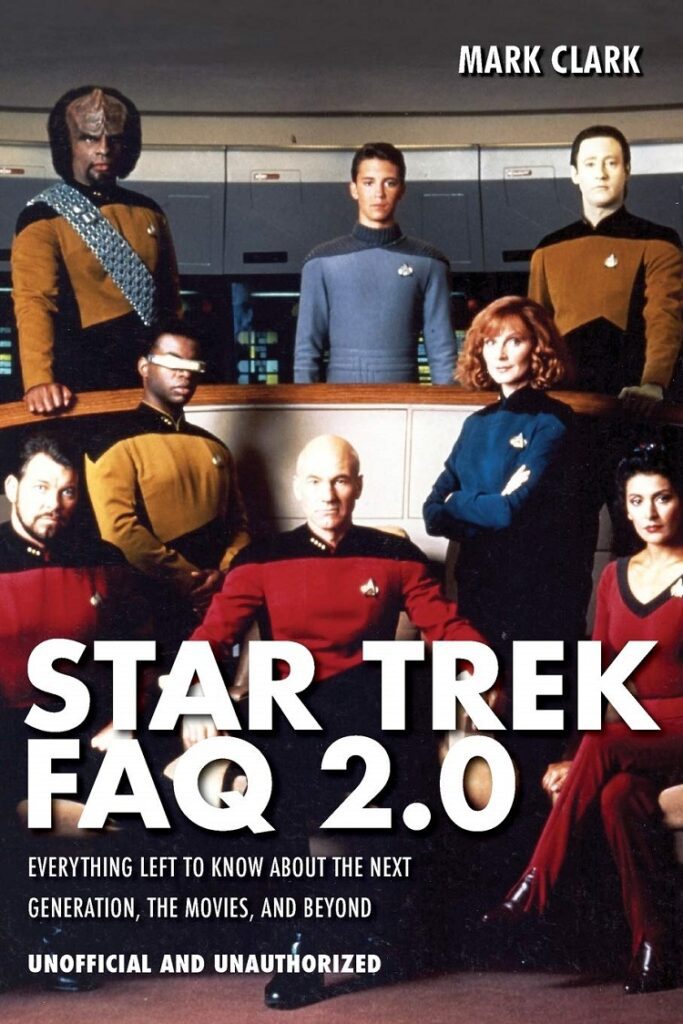
Sometimes I wonder if I am a “Trekkie,” or “Trekker.” What does it take exactly? A working knowledge of every episode of the original Star Trek series, and The Next Generation, plus the films? A visceral hatred for Star Trek Into Darkness? Put a check-mark in all of the above boxes for me. Maybe it is the books, of which there are literally hundreds. If you have them all, I think it would be safe to call you a Trekker.
There are two books that I think even the most casual of fans should own though. The first was published in 2012, The Star Trek FAQ: Everything Left to Know about the First Voyages of Starship Enterprise by Mark Clark. The second is the recent Star Trek FAQ 2.0: Everything Left to Know about The Next Generation, the Movies, and Beyond, also by Clark.
The full titles of these FAQ books are a mouthful, but the 2.0 edition lives up to all it promises. I became a big fan of the original series in syndication as a teenager, but if forced to choose between the two, I would have to pick The Next Generation as my favorite. Clark’s first Trek FAQ was very good, so I was excited when I heard about this one. 2.0 does not disappoint either, although it is structured somewhat differently from the previous one.
The author acknowledges this in his Introduction. While his initial intention was for the two books share a similar outline, he realized that the subject matter dictated a different approach. I think it worked out well.
A fairly standard characteristic of the FAQ books is that they are made up of self-contained chapters, and can be read in any order. This is true of 2.0 to a degree, although Clark recommends that the reader approach it from front to back. I concur, as this book is basically a chronological account of the Trek franchise from 1979 to 2009. The bookends are Star Trek: The Motion Picture (1979) and Star Trek (2009), although there is a brief mention Star Trek Into Darkness at the very end. Into Darkness had not yet been released when the book went to press.
Clark’s first Trek FAQ ended with Paramount green-lighting Star Trek: The Motion Picture. In 2.0 we see a cult favorite become a phenomenon. In the 30 years covered, there were four television series, and ten feature films. One look at the cover will tell you the main story though, as it features the cast of Star Trek: The Next Generation. The majority of the text is devoted to the seven seasons of TNG, the cast of TNG, and the first ten films. Besides season overviews, there are synopsis reviews of all 176 TNG episodes, as well as full chapters devoted to each movie. Much of the material is familiar, but some of it I had never heard before. In any case, it is nice to have it all together in one place like this.
All of that information takes up a fair amount of space, but at 420 pages, with 40 chapters, there is quite a bit more as well. Clark fills in the gaps with chapters such as “Heroes: Guest Stars and Secondary Cast Members,” “Villains: Guest Stars and Cast Members,” “Thine Own Self: The Post-Trek Careers of the Next Generation Cast,” and “Do It Yourself: New Voyages and Other Fan Made Treks.” My only complaint is that I would have very much appreciated more in-depth discussions of Star Trek: Deep Space Nine; Star Trek: Voyager; and Star Trek: Enterprise over some of these essays.
Clark does mention these programs of course; he just does not go into much detail about them. For all I know, there may be a Trek FAQ 3.0 in the works to focus on them. With a combined total of 446 episodes from all three series, there is quite a bit to talk about. Too much for a full examination here, obviously.
The chronological outline of this book really pays off when we come to the 25th anniversary of Star Trek in 1991. This was the year of the final original cast film, Star Trek VI: The Undiscovered Country (1991), the fifth season of TNG, and preparations for the launch of DS9. It was an exciting time for viewers, but the workload was immense for those behind the scenes. Clark details all of it, and it makes for some very compelling reading.
There are four “Shining Moments” chapters that I enjoyed. Patrick Stewart, Brent Spiner, and Michael Dorn rate full chapters, and the fourth celebrates outstanding performances from Jonathan Frakes, LeVar Burton, Marina Sirtis, Gates McFadden, Wil Wheaton, and Denise Crosby. I fully agree with Clark’s assessments, as I generally did throughout the book. I also liked “Mess Call: The Food and Beverages of Star Trek,“ especially the bits about alcohol. Who can forget the moment in “Relics” when Scotty (James Doohan) is served a drink by Data (Brent Spiner), and asks what it is. Data’s reply is classic: “It is… it is green.”
The final “Star Trek Lives! The Continuing Voyages” includes a discussion of the blockbuster J.J. Abrams-directed Star Trek, and looks ahead to Star Trek Into Darkness. He also details some very intriguing proposals of the early 2000s, which never got off the drawing board. Despite the critical drubbing Into Darkness took, the film was a huge summer hit. A third Abrams Trek film is a distinct possibility, and do not count out television. Paramount may have overdosed viewers with DS9, Voyager, and Enterprise, but there has been no new Trek on TV since 2005. With the right idea, who knows?
With the 50th anniversary looming in 2016, it is a sure bet that Trek will continue, in one form or another. For now, Star Trek FAQ 2.0 is an excellent look at the amazing second act of the franchise.